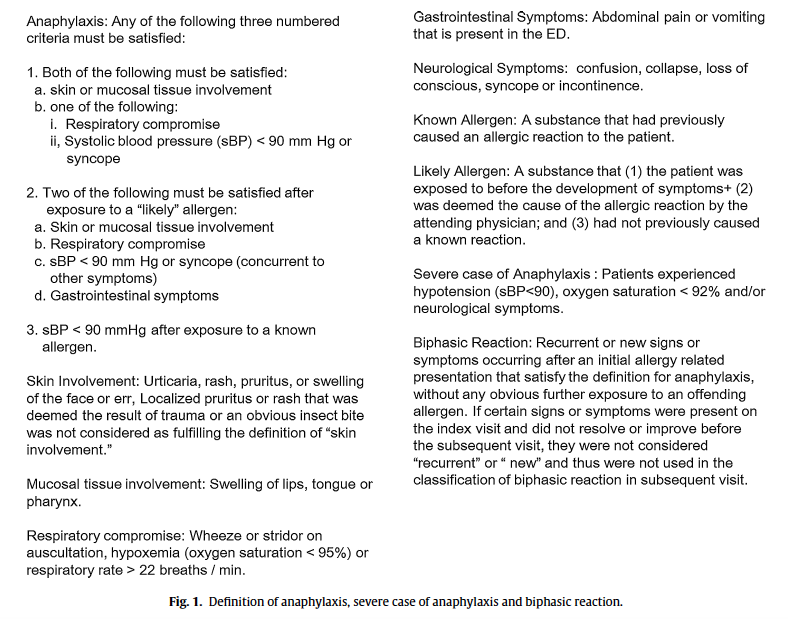Background
Anaphylaxis is an acute, potentially life-threatening emergency. In patients with compromise of their airway, breathing or circulation, epinephrine (epi) should be rapidly administered. There is little data describing the differences in epi administration and cardiac complications among older and younger patients with anaphylaxis. Older patients have been identified as a vulnerable group for severe or fatal anaphylaxis. Despite this, older patients appear less likely to receive epi injection, possibly due to concern for its side effects It is unclear, however, whether epi use is associated with a higher frequency of side effects in older patients with anaphylaxis.
Clinical Question
Is there a difference in epi administration and subsequent cardiovascular complications in older (>50) vs younger (<50) patients presenting to the emergency department (ED) with anaphylaxis?
Population
Patients >/= 18 years of age with registered complaint of “allergic reaction” on EMR at two hospitals in Vancouver 4/2007 to 3/2012
Outcomes
Primary: Proportion of patients with anaphylaxis treated with epinephrine
Secondary
• Proportion of patients with post-epi cardiovascular complications (further classified by route)
• Proportion of patients who received excessive dose of epinephrine
Definitions
• Excessive dose of epi: > 0.5mg IM or > 0.1 mg IV (100 micrograms)
• Cardiovascular complications: new onset vfib or vtach, aflutter or afib, or MAY, acute stroke defined as new neurologic deficit, elevated cardiac troponin, or new ischemic ekg findings
Design
Retrospective cohort study
Excluded
• Patients with primary diagnosis of asthma
• Patients on ACE inhibitors
• Patients with history of non-allergic angioedema
Primary Results

- Identified allergic reactions: n = 2995
- Anaphylaxis: n = 492
- > 50 years: n = 122
- < 50 years: n = 370
Critical Findings
| > 50 years | < 50 years | Odds Ratio (95% CI) | |
| Receiving Epi | 36% (44/122) | 61% (225/370) | 0.3 (0.2-0.5) |
| CV Complications | 9.1% (4/44) | 0.4% (1/225) | 22.4 (2.1-1129.8) |
| Excess Epi Dosing | 15.9% (7/44) | 0.9% (2/225) | 20.7 (3.8-211.7) |
- Of the CV complications, 3 occurred after IV epi administration and 2 after IM epi administration
- Of excess epi doses, 6/9 occurred after IV epi administration and 3/9 occurred after IM epi administration
Strengths
- Study asks a clinically important question that is not well studied
- Data abstractors were blinded to the study hypothesis
- Inter-observer agreement (kappa) for data extraction was high (k = 0.9)
- Follow up was performed at 7 days by cross referencing patients in the regional database
Limitations
- The study is not prospective or randomized and, thus, can only show an association, not causation
- Cardiovascular complications were patient symptom triggered, thus silent events were missed
- There is no discussion of overall patient outcomes in terms of their anaphylaxis course (i.e. did patients get worse, intubations, admissions etc)
- There is no discussion of cardiac events that occurred in the absence of epi administration (i.e. patients were stressed from anaphylaxis leading to a cardiac event)
- Physicians may have refrained from giving epi to patients with baseline cardiovascular risk factors, thus leading to underestimation of true proportion of post-epi complications
Other Issues
- None of the cardiac events were of any true significance. Thus, while the rate was higher in older patients, there was no patient harm
- Revisits were only looked for by checking the regional database. Patients may have been seen in an office setting or outside of the region and those events would not be captured
- IV epi was only shown to be “harmful” when the incorrect dose was used. This pertains to any drug i.e. if you use the wrong dose, harm is increased. Despite the errant doses, no patient truly was harmed
Author's Conclusions
“Older patients with anaphylaxis were less likely to receive epi injection. Intramuscular epi appears safe in this population; however, the use of intravenous epi should be avoided in older patients due to the potential of developing serious cardiac complications. “
Our Conclusions
It appears to be safe to give IM epinephrine to both old and young patients with a clinical diagnosis of anaphylaxis. The true rate of post-epi CV complications are likely underestimated but this study showed no patient centered harmful outcomes.
Potential Impact To Current Practice
Epinephrine should not be withheld from any patient who has anaphylaxis, regardless of age or comorbid conditions, as it is a potentially life-saving therapeutic intervention in this setting.
Bottom Line
If epinephrine is administered for anaphylaxis, it should be administered via the IM route regardless of age/co-morbidities. Epinephrine given IV may be associated with adverse CV effects, especially when given in higher than recommended doses and in older patients with possible CV risk factors.
Read More
Core EM: Anaphylaxis
EM: RAP: Strayerisms – Anaphylaxis Rebuttal